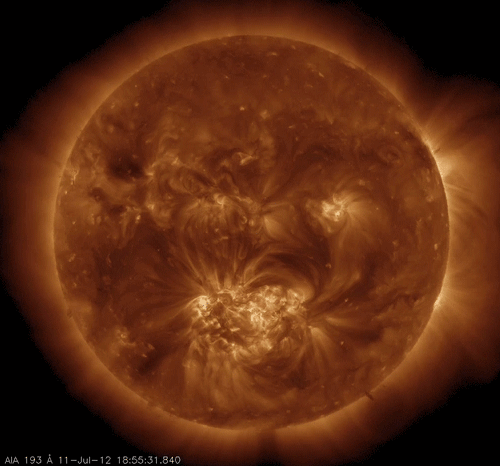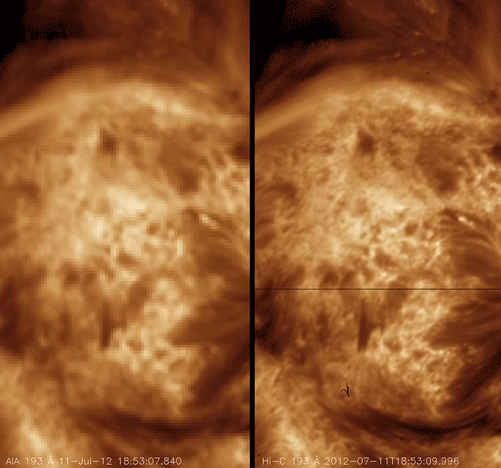Rordes - A.F.K

More Posts from Rordes and Others


THE ATTENDANT by jlillard
http://society6.com/julialillardart
https://www.facebook.com/jlillardart
http://instagram.com/julialillardart

Preparing to Launch for the Sun!
NASA’s Parker Solar Probe has cleared the final procedures in the clean room before its move to the launch pad, where it will be integrated onto its launch vehicle, a United Launch Alliance Delta IV Heavy. This is an historic mission that will revolutionize our understanding of the Sun, where changing conditions can propagate out into the solar system, affecting Earth and other worlds.
Parker Solar Probe will travel through the Sun’s atmosphere, closer to the surface than any spacecraft before it, facing brutal heat and radiation conditions — and ultimately providing humanity with the closest-ever observations of a star.
Seen here inside one half of its 62.7-foot tall fairing, the Parker Solar Probe was encapsulated on July 16, 2018, in preparation for the move from Astrotech Space Operations in Titusville, Florida, to Space Launch Complex 37 on Cape Canaveral Air Force Station, where it will be integrated onto its launch vehicle for its launch that is targeted for August 11, 2018.
Source: NASA





Spatial resolution of Hi-C compared to that of SDO/AIA
The highest resolution data from the corona we currently get on a regular basis are from the Atmospheric Imaging Assembly (AIA) on the Solar Dynamics Observatory (SDO), however, even higher resolution images have been obtained during a sounding rocket flight by the High-resolution Coronal Imager (Hi-C). The scientific objectives of Hi-C are central to the goal of understanding the Sun’s activity and its effects on the terrestrial environment by providing unprecedented views of small-scale structures in the solar atmosphere.
The Hi-C instrument is scheduled to launch on a sounding rocket May 29, 2018. This will be the third launch of the Hi-C instrument.
Image credit: MSFC/NASA

my favorite thing about england is that the word pulp doesnt exist











Cats Who Immediately Regretted Their Poor Life Choices.



-
 veryluckyboy liked this · 5 months ago
veryluckyboy liked this · 5 months ago -
 magimthings liked this · 2 years ago
magimthings liked this · 2 years ago -
 fullastronomyanimeartshark liked this · 3 years ago
fullastronomyanimeartshark liked this · 3 years ago -
 podni-goblin liked this · 3 years ago
podni-goblin liked this · 3 years ago -
 aelizejpg liked this · 3 years ago
aelizejpg liked this · 3 years ago -
 figgldygrak liked this · 3 years ago
figgldygrak liked this · 3 years ago -
 space-ace-ren liked this · 3 years ago
space-ace-ren liked this · 3 years ago -
 daodag liked this · 3 years ago
daodag liked this · 3 years ago -
 gvitch reblogged this · 3 years ago
gvitch reblogged this · 3 years ago -
 gvitch liked this · 3 years ago
gvitch liked this · 3 years ago -
 taxodium-distichum liked this · 3 years ago
taxodium-distichum liked this · 3 years ago -
 dshinterests1 liked this · 3 years ago
dshinterests1 liked this · 3 years ago -
 c3nobit3s liked this · 3 years ago
c3nobit3s liked this · 3 years ago -
 theinvisibledreamergirl liked this · 3 years ago
theinvisibledreamergirl liked this · 3 years ago -
 bandlesscaptain reblogged this · 3 years ago
bandlesscaptain reblogged this · 3 years ago -
 barbariandoggolord liked this · 3 years ago
barbariandoggolord liked this · 3 years ago -
 waitapu reblogged this · 3 years ago
waitapu reblogged this · 3 years ago -
 preyforyourdeath reblogged this · 3 years ago
preyforyourdeath reblogged this · 3 years ago -
 preyforyourdeath liked this · 3 years ago
preyforyourdeath liked this · 3 years ago -
 akhaziz liked this · 3 years ago
akhaziz liked this · 3 years ago -
 cureklibatur reblogged this · 3 years ago
cureklibatur reblogged this · 3 years ago -
 cureklibatur liked this · 3 years ago
cureklibatur liked this · 3 years ago -
 melissaphoenix liked this · 3 years ago
melissaphoenix liked this · 3 years ago -
 glymphatics liked this · 4 years ago
glymphatics liked this · 4 years ago -
 vimehemii reblogged this · 4 years ago
vimehemii reblogged this · 4 years ago -
 vimehemii liked this · 4 years ago
vimehemii liked this · 4 years ago -
 dsy-b liked this · 4 years ago
dsy-b liked this · 4 years ago -
 ocudeus reblogged this · 4 years ago
ocudeus reblogged this · 4 years ago -
 ocudeus liked this · 4 years ago
ocudeus liked this · 4 years ago -
 ageanblueisntreal reblogged this · 4 years ago
ageanblueisntreal reblogged this · 4 years ago -
 ageanblueisntreal liked this · 4 years ago
ageanblueisntreal liked this · 4 years ago -
 roeroe478 liked this · 4 years ago
roeroe478 liked this · 4 years ago -
 dragonval007 liked this · 4 years ago
dragonval007 liked this · 4 years ago -
 jello-octops liked this · 4 years ago
jello-octops liked this · 4 years ago -
 thecunningslytherin02 liked this · 4 years ago
thecunningslytherin02 liked this · 4 years ago -
 blackberry-rain liked this · 4 years ago
blackberry-rain liked this · 4 years ago -
 happynes998 liked this · 4 years ago
happynes998 liked this · 4 years ago -
 thejoyofawkward liked this · 4 years ago
thejoyofawkward liked this · 4 years ago -
 theimaginaryflower liked this · 4 years ago
theimaginaryflower liked this · 4 years ago -
 vamp-yre reblogged this · 4 years ago
vamp-yre reblogged this · 4 years ago -
 vamp-yre liked this · 4 years ago
vamp-yre liked this · 4 years ago -
 no-terfs-no-swerfs-no-fascists reblogged this · 4 years ago
no-terfs-no-swerfs-no-fascists reblogged this · 4 years ago -
 no-terfs-no-swerfs-no-fascists liked this · 4 years ago
no-terfs-no-swerfs-no-fascists liked this · 4 years ago -
 kloppsa liked this · 4 years ago
kloppsa liked this · 4 years ago -
 deeavali liked this · 4 years ago
deeavali liked this · 4 years ago -
 animee10 liked this · 4 years ago
animee10 liked this · 4 years ago